©2023 – Dr Dennis Shavelson – FootHelpers | concept by www.thewriteonecs.com
The BioKickstand
The Kickstand of the Foot
Restorative Biomechanics™ is a modern way of looking at the human body as a group of Joints controlled by a variety of complex machines. It views the body as an integrated system operating from the ground up, rather than as a collection of separate parts. We are made up of bones, joints, connective tissue (fascia) muscles, tendon,ligaments, fascia and other tissues that work together to allow us to stand, move and task.
The joints of the body are the moving parts of our orthopedic and connective tissue feet and postures. All joints with rare exceptions (the joints of the skull are fused together at a young age) have tri-plane motions called Pronation and Supination that exist within a specific Range of Motion (ROM).
“OUR FEET ARE THE ONLY ORGANS IN CONTACT WITH THE GROUND WHEN WE ARE STANDING ERECT OR TASKING MAKING THEM INDESPENSIBLE and IRREPLACEABLE” Dr Dennis Shavelson
“OUR FEET ARE THE PRIMARY MOTORS OF OUR MOVEMENTS and TASKING ON EARTH’. Dr Dennis Shavelson.
“OUR FEET ARE THE PRIMARY DECELERATORS, DIRECTION CHANGERS, UP and DOWN MOVERS, DANCERS and ATHLETIC PERFORMERS ON EARTH’. Dr Dennis Shavelson.
Other tissues in the body such as the myofascial organ, tendons and ligaments also play a part in joint stability and movement. These tissues connect the bones and muscles throughout the body and help to transmit forces between them. Each of the segments of the posture has an oscillating equilibrium between being flexible and free to move and being rigid (stiff) for stability. When flexible, the space between the joint segments (joint spaces) are free to move When rigid, the joint surface come in contact with each other creating deterioration of that segment (see images).
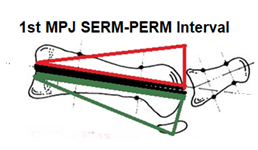 All joints have two motions in opposite directions called supination and pronation each with an endpoint. The supination endpoint is the Supinatory End Range of Motion or SERM and the pronatory endpoint is the Pronatory End Range of Motion or PERM. Motion between SERM and PERM is known as SERM-PERM Interval (see image). Movement within the SERM-PERM Interval is efficient and injury free and SERM and PERM is where both stability and deterioration begin.
All joints have two motions in opposite directions called supination and pronation each with an endpoint. The supination endpoint is the Supinatory End Range of Motion or SERM and the pronatory endpoint is the Pronatory End Range of Motion or PERM. Motion between SERM and PERM is known as SERM-PERM Interval (see image). Movement within the SERM-PERM Interval is efficient and injury free and SERM and PERM is where both stability and deterioration begin.
The BioKickstand of the Foot Explained
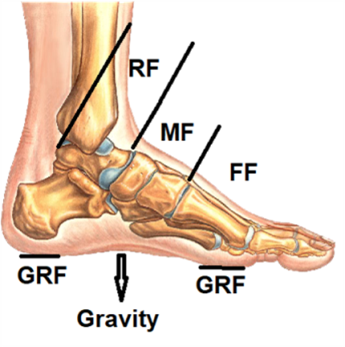 The foot has three postural segments, the rearfoot, the midfoot and the forefoot. The rearfoot and forefoot contact the ground and there is a domed roof that connects the two called The Vault of the Foot (see image).The forefoot has two main areas that hold weight against the ground. The first is behind the pinky toe. The second is behind the
The foot has three postural segments, the rearfoot, the midfoot and the forefoot. The rearfoot and forefoot contact the ground and there is a domed roof that connects the two called The Vault of the Foot (see image).The forefoot has two main areas that hold weight against the ground. The first is behind the pinky toe. The second is behind the 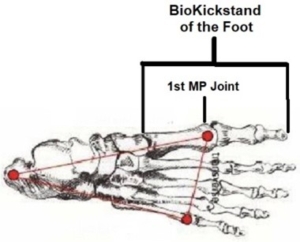 great toe (the bunion area). The 1st MP Joint (the bunion joint) is capable of being both stiff and rigid or flexible and adaptable. This spot pinpoints the location of the most complex biomachine of the posture. It is called The BioKickstand of the Foot.
great toe (the bunion area). The 1st MP Joint (the bunion joint) is capable of being both stiff and rigid or flexible and adaptable. This spot pinpoints the location of the most complex biomachine of the posture. It is called The BioKickstand of the Foot.
The BioKickstand of the Foot serves as the control center of human stance and movement. The BioKickstand of the Foot engages when pressed to the ground with enough force at the great toe joint (the 1st MTPJ), to begin a chain of events capable of stiffening and arching the independent bones of the medial forefoot to close pack and function as if one bone. It also can disengage and become more flexible and collapsed.
To better understand the BioKickstand, let’s compare it to a Scooter. A Scooter has a back wheel and a front wheel that contact the ground and it cannot stand independently until its Kickstand is manually engaged. The human foot, like a scooter, has a rearfoot and a forefoot that contact the ground making it excellent for movement in all directions. It also has a BioKickstand at the 1st MP Join that can drive a weighted 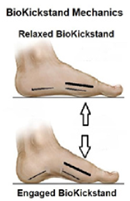 1st metatarsal head down into the ground forcefully enough to stabilize the foot. This is known as the BioKickstand Anchored
1st metatarsal head down into the ground forcefully enough to stabilize the foot. This is known as the BioKickstand Anchored 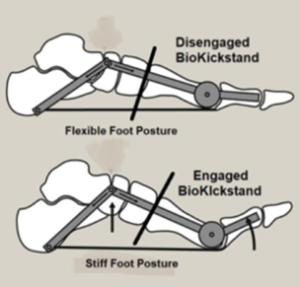 Position (see Image). This position is the mainstay for independent standing, lifting, pivoting and shifting of the body. If the BioKickstand cannot engage in phase and with power thousands of times a day, the entire performance and health of the human posture suffers, degenerates and ages. When movement is necessary, the BioKickstand disengages due to the upward force of GRF creating a new chain of events that makes the foot and posture more flexible and adaptable for movement, This is known as the BioKickstand Relaxed Position (see Figure).
Position (see Image). This position is the mainstay for independent standing, lifting, pivoting and shifting of the body. If the BioKickstand cannot engage in phase and with power thousands of times a day, the entire performance and health of the human posture suffers, degenerates and ages. When movement is necessary, the BioKickstand disengages due to the upward force of GRF creating a new chain of events that makes the foot and posture more flexible and adaptable for movement, This is known as the BioKickstand Relaxed Position (see Figure).
In a Working BioKickstand, the pressure forces under the Kickstand are greatest under the kickstand. It is engaged and the chain of events is working.
In a Broken BioKickstand, there is almost no weight under the great toe joint. It has moved to under the 2nd and 3rd metatarsal joints into the disengaged position and the foot and posture are too flexible for normal standing and moving.
A “Broken” BioKickstand is defined as one that is not capable of engaging or anchoring the first metatarsal with enough force to create or maintain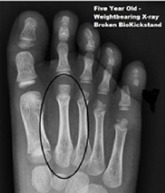 the chain of events that engages the foot and posture. This leaves the foot and posture too flexible, poorly stabilized, supported and balanced resulting in structural collapse and deformity, degeneration and injury to the bones and soft tissues. This leads to a predictable closed chain of pathological events up the posture to the head and neck but especially from the foot up to the lower lumbar area (L-4/L-5).
the chain of events that engages the foot and posture. This leaves the foot and posture too flexible, poorly stabilized, supported and balanced resulting in structural collapse and deformity, degeneration and injury to the bones and soft tissues. This leads to a predictable closed chain of pathological events up the posture to the head and neck but especially from the foot up to the lower lumbar area (L-4/L-5).
Anecdotally, those who have worked with and experienced with focusing on the Biomachine that is The BioKickstand have determined that 70% or more of all people are living life on Broken Kickstands, some as young as 5 years of age (see Image – periosteum 2-3 > 1, thick 2nd met, separation base of 1-2).
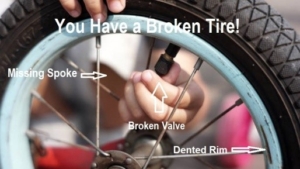 Before Foot Centering Biomechanics professionals targeted the pain and complaints of patients and clients with goals of reducing or eliminating those pains and complaints. They diagnosed events such as plantar fascitis, knee pain or sciatica but have never sought to repair the real culprit: A Broken BioKickstand. As an illustration, let’s say we have a broken tire on a bicycle. It has a bent rim, a deflated bladder and three missing spokes. You can put air in the tire and fix the rim but you have not fixed the tire as a working machine (see image).
Before Foot Centering Biomechanics professionals targeted the pain and complaints of patients and clients with goals of reducing or eliminating those pains and complaints. They diagnosed events such as plantar fascitis, knee pain or sciatica but have never sought to repair the real culprit: A Broken BioKickstand. As an illustration, let’s say we have a broken tire on a bicycle. It has a bent rim, a deflated bladder and three missing spokes. You can put air in the tire and fix the rim but you have not fixed the tire as a working machine (see image).
A bike store tells the client: You Have A Broken Tire!
You tell a patient with a fracture: You have a Broken Bone!
Your biomechanical fun, practice, income and your reputation will never be the same if you start telling your patients and clients: You have a Broken BioKickstand!
Email drshavelson@gmail.com or click here to set up a discovery discussion or CLICK BUTTON below to begin the Certification Process.

